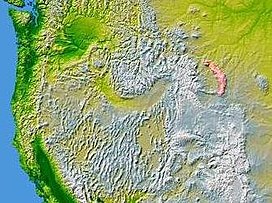Big Horn Mountains
| Bighorn Mountains | |
|---|---|

Big Horn range in Northern Wyoming
|
|
| Highest point | |
| Peak | Cloud Peak |
| Elevation | 13,175 ft (4,016 m) |
| Coordinates | 44°23′N 107°10′W / 44.383°N 107.167°WCoordinates: 44°23′N 107°10′W / 44.383°N 107.167°W |
| Geography | |
| Country | United States |
| States | Montana and Wyoming |
| Parent range | Rocky Mountains |
| Borders on | Absaroka Range |
| Geology | |
| Orogeny | Laramide orogeny |
The Bighorn Mountains (Apsáalookěi: Basawaxaawúua or Iisaxpúatahchee Isawaxaawúua) are a mountain range in northern Wyoming and southern Montana in the United States, forming a northwest-trending spur from the Rocky Mountains extending approximately 200 miles (320 km) northward on the Great Plains. They are separated from the Absaroka Range, which lie on the main branch of the Rockies in western Wyoming, by the Bighorn Basin.
The Bighorns were uplifted during the Laramide orogeny beginning approximately 70 million years ago. They consist of over 9,000 feet (2,700 m) of sedimentary rock strata laid down before mountain-building began: the predominantly marine and near-shore sedimentary layers range from the Cambrian through the Lower Cretaceous, and are often rich in fossils. There is an unconformity where Silurian strata were exposed to erosion and are missing. Following the uplift, large volumes of sediments, rich in early Tertiary fossils, were deposited in the adjoining basins. Though many cirques, U-shaped valleys and glacial lakes can be found in the mountain range, the only remaining active glacier is the Cloud Peak Glacier, which is on the east slope of Cloud Peak.
The highest peaks within the Bighorns are located in Wyoming in the 1.12 million acre (4,500 km²) Bighorn National Forest. Two peaks rise to over 13,000 feet (3,960 m) Cloud Peak (13,175 ft, 4013 m) and Black Tooth Mountain (13,005 ft, 3964 m). There are a dozen more that rise to over 12,000 feet (3,650 m). From the east the mountains present a vertical relief of over 8,000 feet (2,450 m), rising abruptly from the plains. Overall, the Bighorns are more rounded than their sister mountain ranges to the west.
...
Wikipedia

